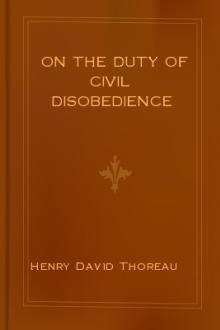Essays - Henry David Thoreau (best e reader for android .TXT) 📗

- Author: Henry David Thoreau
Book online «Essays - Henry David Thoreau (best e reader for android .TXT) 📗». Author Henry David Thoreau
About six o’clock we started for Quebec, one hundred and eighty miles distant by the river; gliding past Longueil and Boucherville on the right, and Pointe aux Trembles, “so called from having been originally covered with aspens,” and Bout de l’Isle, or the end of the island, on the left. I repeat these names not merely for want of more substantial facts to record, but because they sounded singularly poetic to my ears. There certainly was no lie in them. They suggested that some simple, and, perchance, heroic human life might have transpired there. There is all the poetry in the world in a name. It is a poem which the mass of men hear and read. What is poetry in the common sense, but a string of such jingling names? I want nothing better than a good word. The name of a thing may easily be more than the thing itself to me. Inexpressibly beautiful appears the recognition by man of the least natural fact, and the allying his life to it. All the world reiterating this slender truth, that aspens once grew there; and the swift inference is, that men were there to see them. And so it would be with the names of our native and neighboring villages, if we had not profaned them.
The daylight now failed us, and we went below; but I endeavored to console myself for being obliged to make this voyage by night, by thinking that I did not lose a great deal, the shores being low and rather unattractive, and that the river itself was much the more interesting object. I heard something in the night about the boat being at William Henry, Three Rivers, and in the Richelieu Rapids, but I was still where I had been when I lost sight of Pointe aux Trembles. To hear a man who has been waked up at midnight in the cabin of a steamboat, inquiring, “Waiter, where are we now?” is, as if at any moment of the Earth’s revolution round the sun, or of the system round its centre, one were to raise himself up and inquire of one of the deck hands, “Where are we now?”
I went on deck at daybreak, when we were thirty or forty miles above Quebec. The banks were now higher and more interesting. There was an “uninterrupted succession of whitewashed cottages” on each side of the river. This is what every traveller tells. But it is not to be taken as an evidence of the populousness of the country in general, hardly even of the river banks. They have presented a similar appearance for a hundred years. The Swedish traveller and naturalist, Kalm, who descended this river in 1749, says: “It could really be called a village, beginning at Montreal and ending at Quebec, which is a distance of more than one hundred and eighty miles; for the farmhouses are never above five arpens, and sometimes but three asunder, a few places excepted.” Even in 1684 Hontan said that the houses were not more than a gunshot apart at most. Erelong we passed Cape Rouge, eight miles above Quebec, the mouth of the Chaudière on the opposite or south side, New Liverpool Cove with its lumber rafts and some shipping; then Sillery and Wolfe’s Cove and the Heights of Abraham on the north, with now a view of Cape Diamond, and the citadel in front. The approach to Quebec was very imposing. It was about six o’clock in the morning when we arrived. There is but a single street under the cliff on the south side of the cape, which was made by blasting the rocks and filling up the river. Three-story houses did not rise more than one fifth or one sixth the way up the nearly perpendicular rock, whose summit is three hundred and forty-five feet above the water. We saw, as we glided past, the sign on the side of the precipice, part way up, pointing to the spot where Montgomery was killed in 1775. Formerly it was the custom for those who went to Quebec for the first time to be ducked, or else pay a fine. Not even the Governor General escaped. But we were too many to be ducked, even if the custom had not been abolished.24
Here we were, in the harbor of Quebec, still three hundred and sixty miles from the mouth of the St. Lawrence, in a basin two miles across, where the greatest depth is twenty-eight fathoms, and though the water is fresh, the tide rises seventeen to twenty-four feet—a harbor “large and deep enough,” says a British traveller, “to hold the English navy.” I may as well state that, in 1844, the county of Quebec contained about forty-five thousand inhabitants (the city and suburbs having about forty-three thousand); about twenty-eight thousand being Canadians of French origin; eight thousand British; over seven thousand natives of Ireland; one thousand five hundred natives of England; the rest Scotch and others. Thirty-six thousand belong to the Church of Rome.
Separating ourselves from the crowd, we walked up a narrow street, thence ascended by some wooden steps, called the Breakneck Stairs, into another steep, narrow, and zigzag street, blasted through the rock, which last led through a low massive





Comments (0)